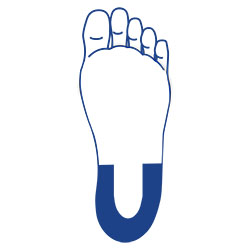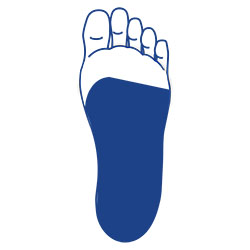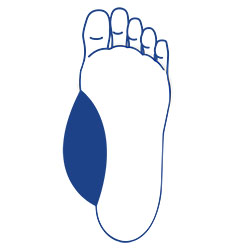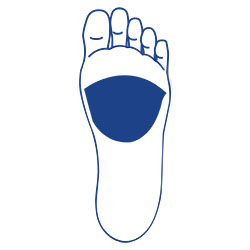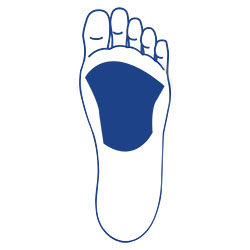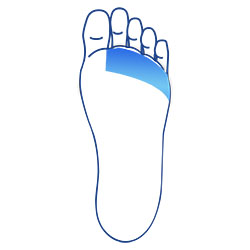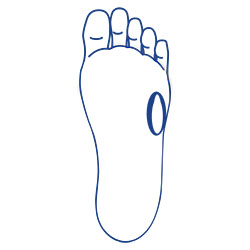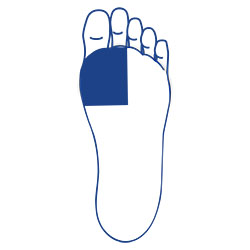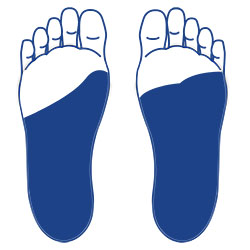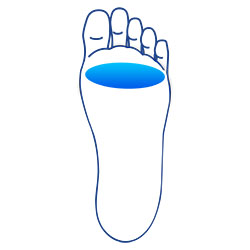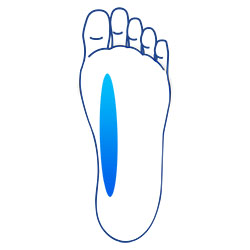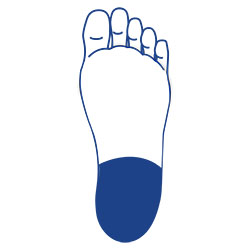Modification
Walk, Run, Dance – We’ve Got You Supported.
1st Ray Cut Out
- An angled cut-out to the orthotic shell under the 1st metatarsal-phalangeal joint at the distal-medial aspect of the orthotic shell.
- Indications: to allow additional plantar flexion of the 1st ray, functional hallux limitus, bunion deformity, sesamoiditis.
High Medial Flange On
- Pad added to the medial side of the orthotic or the shell to provide extra support around the medial longitudinal arch.
- Indication: excessive pronated foot, pes planus, genu valgum, everted feet, navicular pain
- Precautions: in wider fitting shoes it is suggested that this modification is added with an extrinsic rear foot posting. Additionally, orthotics with this modification are best not to be worn in dress or narrow fitting shoes.
MET PAD
- Thick poron pad that is centrally placed on 2-4 metatarsal heads, to spread the metatarsals and recreate the transverse arch.
- Indications: reduced transverse arch, and metatarsalgia.
- Precautions: best to be added bilaterally. Best not to be used for people with tarsal coalition or rigid forefoot.
MET BAR PAD
- Poron bar pad located under 2-4 centered under 3rd metatarsal head proximal to the metatarsal heads.
- Indications: metatarsalgia, dropped transverse arches, claw toes.
- Precautions: not recommended if a patient has rigid forefeet.
Reverse Morton’s Extension
- 3 mm poron or cork pad placed under the 2-5 metatarsal-phalangeal joints.
- Indications: helps to dorsiflex the first toe, sesamoiditis, severe forefoot valgus deformity, plantarflexed first toe.
- Precautions: best not to be used in shoes with a narrow toe box. Additionally, best paired with a metatarsal pad. Contraindicated in patients with forefoot varus.
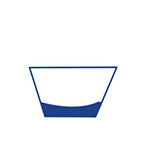
Heel Raise
- Extrinsic heel lift added to the underside of an orthotic.
- Indications: functional leg length discrepancy (LLD), equinus, Achilles tendonitis.
- Precautions: important to indicate which leg requires the heel lift. 3mm heel lift is recommended for equines or Achilles tendonitis. Contraindicated in patients with anatomical leg length inequality.
Rear Foot Posting
- Extrinsic post added to the plantar surface of the orthotic heel.
- Indications: moderate to severe over-pronators, unstable feet, and patient’s that weigh more than 240 lbs.
- Precautions: best to wear in shoes that can accommodate a bulky device.
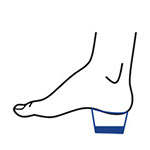
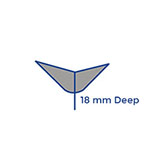
Deep Heel Cup
- 15-20mm depression made in the heel cup of the orthotic shell for better ankle and heel control.
- Orthotic shell with a heel cup that is 15-20mm deeper than normal.
- Indications: severe over pronators, and fat pad atrophy.
- Precautions: best not to wear in tight fitting shoes or those with shallow heel counters.
Arch Fill Reinforced – Arch
- 3-6mm poron arch fill added to the plantar surface of the orthotic.
- Indications: helps add rigidity to the orthotic and mostly used when a patient weighs more than 240 lbs.
- Precautions: best not to wear in narrow or tight-fitting shoes. Contraindicated in patients with cavus or rigid feet.
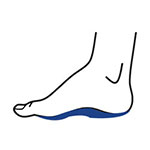
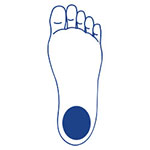
Heel Cushion Center Pocket
- 25-inch hole cut through the orthotic shell under the calcaneus.
- Indication: heel spurs.
- Precaution: works best with an extrinsic rearfoot post and either a full heel cushion or heel spur pad. Contraindicated for patients with non-centrally located heel spur.
Extrinsic ForeFoot Posting (Varus)
- Extra firm posting material added to the distal portion of the plantar surface of the orthotic.
- Indications: non-weight bearing forefoot varus/valgus deformity.
- Precautions: best not to wear in tight fitting shoes.
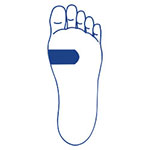
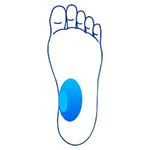
Navicular Pad
- Poron pad placed beneath the distal calcaneus, proximal to the navicular.
- Indication: navicular pain.
Scaphoid Pad
- Poron pad added to the medial side along the medial longitudinal arch.
- Indication: severe over-pronation, a rigid cavus foot or pain in the medial-longitudinal arch.
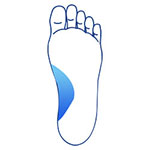
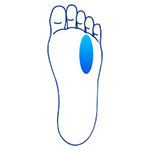
Neuroma Pad
- Teardrop shaped poron pad placed at interdigital space to spread the specified metatarsals.
- Indications: interdigital neuroma, intermetatarsal bursitis
- Precautions: cannot be prescribed with a ¾ length orthotic
Navicular Depression
- Depression made in the shell of the orthotic on the medial side.
- Indication: Navicular pain, accessory navicular type I-III, soft tissue growth of navicular tuberosity.
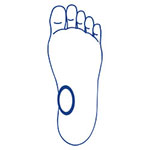
Cuboid Pad
- Poron pad that is placed beneath the distal calcaneus, proximal to the cuboid.
- indications: cuboid pain.
Morton’s Extension
- 3mm poron or cork pad placed at the first metatarsal phalangeal joint.
- Indications: turf toe, hallux rigidus
- Precautions: should be used in conjunction with a metatarsal pad. Additionally, best not to be worn in shoes with narrow toe box.
Gait Plate
- Recommended for children 3-8 years old.
- Indication: children with in-toeing or out-toeing gait
- To induce out-toe gait the distal edge of the foot orthotic shell is cut proximal to the fifth metatarsal head and extended distal from the first metatarsal head to the sulcus of the first toe.
- To induce in-toe gait the distal edge of the foot orthotic shell is cut proximal to the first metatarsal head and extended distal from the fifth metatarsal head to the end of the fifth toe
- Precaution: best to be used in shoes that are flexible enough in the forefoot to allow it to change the angle of flexion.
Toe Crest
- Poron pad placed just proximal to the phalanges and extends from medial to lateral side.
- Indications: hammer toes, claw toes, mallet toes, metatarsalgia
- Precautions: recommended to order this without it being glued on to ensure correct placement.
Plantar Fascia Accomodation
- Depression placed in the shell of the orthotic around the medial plantar fascial ligament to reduce pressure on the plantar fascia.
- Indications: plantar fasciitis.
Heel Cushion
- 3mm poron pad covering the entire heel cup.
- Indications: non-central heel spurs, plantar fasciitis, fat pad atrophy
- Precautions: important to have these pads bilaterally to avoid leg length discrepancy. Additionally, this pad should NOT be used with a heel spur pad. Best not to be worn in shoes with shallow heel counter.
Heel Spur Pad
- 3mm poron U-shaped cut out pad.
- Indications: radiographically confirmed centrally located heel spurs, plantar fasciitis
- Precautions: important to have these pads bilaterally to avoid leg length discrepancy. Additionally, this pad should NOT be used with a full heel cushion. Contraindicated for patients with non-centrally located heel spurs.
